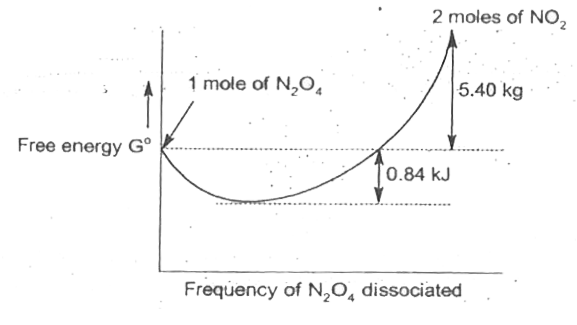A reaction is spontaneous if free energy change ΔG , for the reaction is negative . The question arises, how we can explain , the spontaneous of reversible reaction taking the example of dissociation equilibrium N2O4⇔2NO2(g) the variation of free energy with the fraction of N2O4 dissociated under standard conditions is shown in the figure below.

When 1 mole of N2O4 changes into the equilibrium mixture the volume of ΔG∘ is
0.84 kJ
−0.84kJ
5.40 0.84 kJ
0.84-5.40 kJ
The correct Answer is:B
The lowest point of the plot represents equilibrium mixture. When 1 mole of N2O4 changes into equilibrium mixtture , free energy is lowered by 0.84 kJ, ΔG=−0.84KJ.
Topper's Solved these Questions
- CHEMICAL EQUILIBRIUMBOOK - FIITJEECHAPTER - CHEMICAL EQUILIBRIUMEXERCISE - MATRIX -MATCH TYPE QUESTION
1 Videos
- CHEMICAL EQUILIBRIUMBOOK - FIITJEECHAPTER - CHEMICAL EQUILIBRIUMEXERCISE - REASONING TYPE QUESTION
1 Videos
- CHEMICAL EQUILIBRIUMBOOK - FIITJEECHAPTER - CHEMICAL EQUILIBRIUMEXERCISE - SOLVED PROBLEMS (OBJECTIVE)
18 Videos
- CHEMICAL ENERGETICS BOOK - FIITJEECHAPTER - CHEMICAL ENERGETICS EXERCISE - NUMERICAL BASED QUESTIONS
2 Videos
- CHEMICAL KINETICS AND RADIOACTIVITYBOOK - FIITJEECHAPTER - CHEMICAL KINETICS AND RADIOACTIVITYEXERCISE - Exercise
9 Videos
Similar Questions
A reaction is spontaneous if free energy change ΔG for the reaction is negative . The question arises, how we can explain , the spontaneous reversible reaction. Taking the example of dissociation equilibrium N2O4⇔2NO2(g) the variation of free energy with the fraction of N2O4 dissociated under standard conditions is shown in the figure below.

When 1 mole of N2O4 changes into the equilibrium mixture the value of ΔG∘ is
View SolutionA reaction is spontaneous if free energy change ΔG , for the reaction is negative . The question arises, how we can explain , the spontaneous of reversible reaction taking the example of dissociation equilibrium N2O4⇔2NO2(g) the variation of free energy with the fraction of N2O4 dissociated under standard conditions is shown in the figure below.

When 2 moles of NO2 change into equilibrium mixture the value of ΔG∘ is
View Solution
Knowledge Check
A reaction is spontaneous if free energy change ΔG , for the reaction is negative . The question arises, how we can explain, the spontaneous of reversible reaction taking the example of dissociation equilibrium N2O4⇔2NO2(g) the variation of free energy with the fraction of N2O4 dissociated under standard conditions is shown in the figure below.

When 2 moles of NO2 change into equilibrium mixture the value of ΔG∘ isA(5.40+0.84)kJB(5.40−0.84)kJC(−5.40−0.84)kJD−5.40kJA reaction is spontaneous if free energy change ΔG , for the reaction is negative . The question arises, how we can explain , the spontaneous of reversible reaction taking the example of dissociation equilibrium N2O4⇔2NO2(g) the variation of free energy with the fraction of N2O4 dissociated under standard conditions is shown in the figure below.

The standard free energy change for the conversion of 1 mole of N2O4 into 2 moles of NO2 isA5.40 KJB−5.40KJC(5.4+0.84 )KJD(5.40 +2 ×0.84)kJFor the dissociation equilibrium,
N2O4(g)⇔2NO2(g), the variation of free energy with the fraction of N2O4 dissociated under standard conditions is shown in the figure :

Which of the following statements is/are correct?AThe free energy change for the forward reaction is negativeBThe free energy change for the backward reaction is negativeCThe net free energy change for the complete reaction is positiveDForward reaction is more spontaneous than backward reaction
A reaction is spontaneous if free energy change ΔG , for the reaction is negative .
The question arises, how we can explain , the spontaneous reversible reaction taking the example of dissociation equilibrium ,N2O4⇔2NO2(g).
the variation of free energy with the fraction of N2O4 dissociated under standard conditions is shown in the figure below.

The standard free energy change for the conversion of 1 mole of N2O4 into 2 moles of NO2 is
View SolutionIn the reaction N2O4⇔2NO2, the degree of dissociation of N2O4 increases with the
View SolutionThe degree of dissociation α of the reaction"
N2O4(g)⇔2NO2(g)
can be related to Kp as:
View SolutionThe degree of dissociation α of the reaction"
N2O4(g)⇔2NO2(g)
can be related to Kp as:
View SolutionFor the equilibrium reaction
2NO2(g)⇔N2O4(g) + 60.0 kJ the increase in temperature
View Solution
